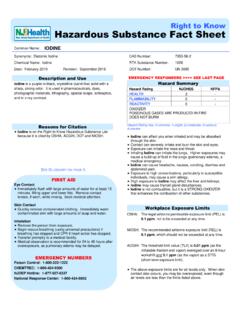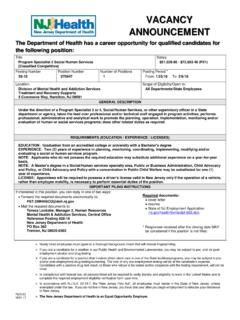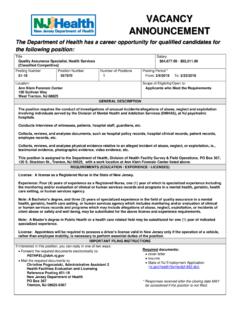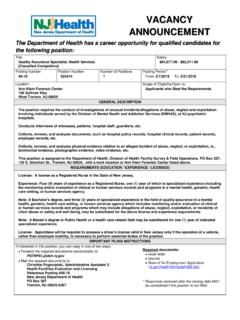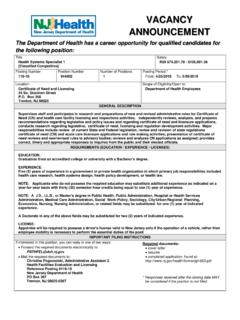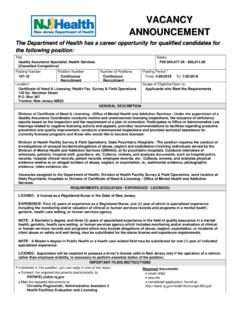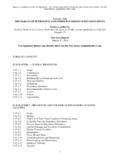Transcription of Right to Know Hazardous Substance Fact Sheet - New Jersey
1 Right to know Hazardous Substance fact Sheet Common Name: carbon DISULFIDE. Synonyms: carbon Bisulfide; carbon Sulfide; Dithiocarbonic CAS Number: 75-15-0. Anhydride RTK Substance Number: 0344. Chemical Name: carbon Disulfide DOT Number: UN 1131. Date: August 2001 Revision: February 2010. Description and Use EMERGENCY RESPONDERS >>>> SEE LAST PAGE. carbon Disulfide is a clear, colorless to light yellow liquid with Hazard Summary an unpleasant, rotten egg odor as a reagent or commercial Hazard Rating NJDOH NFPA. grade. Pure carbon Disulfide has a sweet, pleasant odor. It HEALTH - 3.
2 Is used to make rayon, cellophane and other chemicals, as a FLAMMABILITY - 4. solvent, and a flotation agent. REACTIVITY - 0. TERATOGEN. f ODOR THRESHOLD = to ppm FLAMMABLE. f Odor thresholds vary greatly. Do not rely on odor alone to POISONOUS GASES ARE PRODUCED IN FIRE. determine potentially Hazardous exposures. CONTAINERS MAY EXPLODE IN FIRE. Hazard Rating Key: 0=minimal; 1=slight; 2=moderate; 3=serious;. 4=severe Reasons for Citation f carbon Disulfide can affect you when inhaled and may be absorbed through the skin. f carbon Disulfide is on the Right to know Hazardous f carbon Disulfide may be a TERATOGEN and may cause Substance List because it is cited by OSHA, ACGIH, DOT, reproductive damage.
3 HANDLE WITH EXTREME CAUTION. NIOSH, DEP, IRIS, NFPA and EPA. f Contact can irritate and burn the skin and eyes. Prolonged or f This chemical is on the Special Health Hazard Substance repeated exposure can cause drying and cracking of the skin with List. redness and blisters. f carbon Disulfide can cause nausea, vomiting, diarrhea and abdominal pain. f Exposure can cause headache, dizziness, lightheadedness, passing out and even death. SEE GLOSSARY ON PAGE 5. f High or repeated exposure may damage the nerves, causing weakness, pins and needles, and poor coordination in the arms and legs.
4 FIRST AID f Repeated exposure may cause personality changes, such as Eye Contact depression, anxiety or irritability. f Immediately flush with large amounts of water for at least 15 f carbon Disulfide may damage the liver and kidneys, and affect the minutes, lifting upper and lower lids. Remove contact heart. lenses, if worn, while flushing. Seek medical attention. f carbon Disulfide is a FLAMMABLE LIQUID and a DANGEROUS. FIRE HAZARD. f carbon Disulfide has a very low ignition temperature. Contact with Skin Contact hot steam pipes, ordinary light bulbs, sparks, friction or shock can f Quickly remove contaminated clothing.
5 Immediately wash ignite carbon Disulfide or its vapors. contaminated skin with large amounts of soap and water. Seek medical attention. Workplace Exposure Limits Inhalation OSHA: The legal airborne permissible exposure limit (PEL) is f Remove the person from exposure. 20 ppm averaged over an 8-hour workshift, 30 ppm as an f Begin rescue breathing (using universal precautions) if acceptable ceiling, and 100 ppm as a maximum peak above breathing has stopped and CPR if heart action has stopped. the acceptable ceiling concentration, not to be exceeded f Transfer promptly to a medical facility.
6 During any 30-minute work period. NIOSH: The recommended airborne exposure limit (REL) is 1 ppm averaged over a 10-hour workshift and 10 ppm, not to be EMERGENCY NUMBERS exceeded during any 15-minute work period. ACGIH: The threshold limit value (TLV) is 1 ppm averaged over an Poison Control: 1-800-222-1222. 8-hour workshift. CHEMTREC: 1-800-424-9300. NJDEP Hotline: 1-877-927-6337 f carbon Disulfide may be a teratogen in humans. All contact with this chemical should be reduced to the lowest possible level. National Response Center: 1-800-424-8802 f The above exposure limits are for air levels only.
7 When skin contact also occurs, you may be overexposed, even though air levels are less than the limits listed above. carbon DISULFIDE Page 2 of 6. Determining Your Exposure Other Effects f Prolonged or repeated exposure can cause drying and f Read the product manufacturer's Material Safety Data cracking of the skin with redness and blisters. Sheet (MSDS) and the label to determine product f High or repeated exposure may damage the nerves, causing ingredients and important safety and health information weakness, pins and needles, and poor coordination in the about the product mixture.
8 Arms and legs. f Repeated exposure may cause personality changes, such f For each individual Hazardous ingredient, read the New as depression, anxiety or irritability, memory and hearing Jersey Department of Health Hazardous Substance fact loss. Sheet , available on the RTK Program website f carbon Disulfide may damage the liver and kidneys, and ( ) or in your facility's RTK affect the heart. Central File or Hazard Communication Standard file. f You have a Right to this information under the New Jersey Worker and Community Right to know Act and the Public Medical Employees Occupational Safety and Health (PEOSH) Act Medical Testing if you are a public worker in New Jersey , and under the For frequent or potentially high exposure (half the TLV or federal Occupational Safety and Health Act (OSHA) if you greater), the following are recommended before beginning are a private worker.
9 Work and at regular times after that: f The New Jersey Right to know Act requires most f Liver and kidney function tests employers to label chemicals in the workplace and requires public employers to provide their employees with If symptoms develop or overexposure is suspected, the information concerning chemical hazards and controls. following are recommended: The federal OSHA Hazard Communication Standard (29. f Exam of the nervous system CFR ) and the PEOSH Hazard Communication f EKG. Standard ( 12:100-7) require employers to provide f Evaluate for brain effects such as changes in memory, similar information and training to their employees.
10 Concentration, sleeping patterns and mood (especially irritability and social withdrawal), as well as for headaches This fact Sheet is a summary of available information and fatigue. Consider evaluations of the cerebellar, regarding the health hazards that may result from exposure. autonomic and peripheral nervous systems. Positive and Duration of exposure, concentration of the Substance and other borderline individuals should be referred for factors will affect your susceptibility to any of the potential neuropsychological testing. effects described below. Any evaluation should include a careful history of past and present symptoms with an exam.
